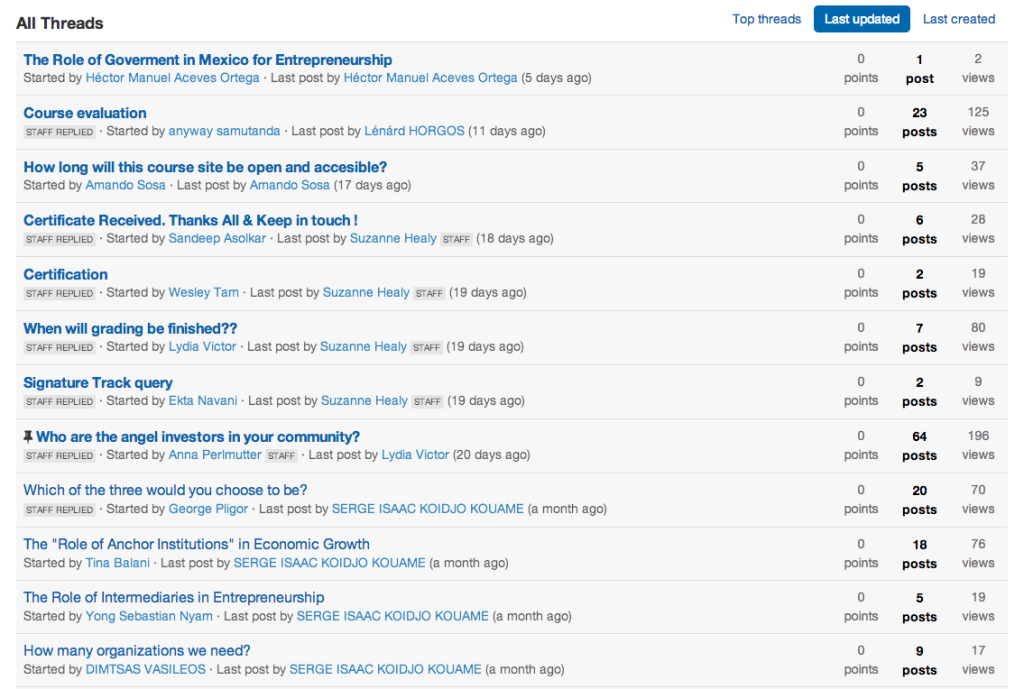by Laurie Pickard | Jul 20, 2014 | Community and Networking, Courses, Platforms, and Profs

If you’ve been reading my blog for a while, then you know that my MOOC pet peeve is when professors require students to post on discussion forums as a part of the course grade. It creates a lot of meaningless chatter - one person writes something mildly intelligent, and a hundred others post something to the effect of “I agree.” In general, I avoid courses that come with such a requirement. But I decided to look past this bias when I registered for “Beyond Silicon Valley: Growing Entrepreneurship in Transitioning Economies.” As I’ve written previously, this course was enormously relevant to my work. So rather than let my negative feelings about obligatory posting get in the way of my experience, I decided to make the course a laboratory for experimenting with how to get the maximum value out of discussion forums.
Here is what I learned:
1. Skip the Introductions Thread
Maybe you want to glance through the introductions, skimming for anything particularly interesting. But in general, the introductions thread is a blur of names and nationalities and people expressing their excitement about the course. Instead of making that your starting point, I suggest thinking about the kinds of people you’d be most interested in engaging with or what you’re hoping to learn in the course. Then instead of reading post by post, search the entire discussion forum on those topics and see what comes up. For example, I usually start by searching on “Rwanda” and “Africa” to see who else is taking the course from my neck of the woods.
If nothing comes up, or if the posts on your topics of interest are scattered within the forum, start your own discussion thread based on geography, background, or field of interest.
2. Fill Out Your Profile, and Include a Photo
This is really important. Savvy social media users always do a bit of investigation on who they’re dealing with before responding to a post. This isn’t creepy, it’s smart. On your own profile, include a very short summary with one or two interesting facts about who you are and what you do, who you’re hoping to interact with in the course (optional), as well as links to any other social media you want people to reach out to you on.
If you’re stuck for what to write, try this template:
“I’m a _______________________ working on _________________________. I’m taking MOOCs in order to ______________________________. I’d love to connect with others who share my interest in _____________________ and _________________________. You can also find me on LinkedIn, Facebook, Twitter, and _________________________. “
For example:
“I’m an international development professional working on entrepreneurship and public-private partnerships in Kigali, Rwanda. I’m taking business courses as part of project to construct a free MBA equivalent out of MOOCs. I’d love to connect with others who share my interests in development and entrepreneurship or my enthusiasm for MOOCs. You can also find me on LinkedIn, Facebook, Twitter, or on my website at www.nopaymba.com.”
When others in the course post interesting comments, check their profiles before responding. You may find that you’re interacting with someone in the industry you’d like to move into, and you now have a great point of entry for a conversation.
3. Facilitators Make a Difference
The professor of “Beyond Silicon Valley,” Michael Goldberg, was a stellar forum facilitator. Throughout the course, I often wondered how he found the time to make so many personal connections, partcipate in so many discussions, and respond to so many comments. He helped keep discussions on track, made introductions among students, and generally kept the level of engagement high.
But not every course is led by a facilitator with as much verve and enthusiasm as Professor Goldberg. What then?
If you’re in a course that lacks strong facilitation, I suggest trying to play that role yourself. While they don’t have the star power of professors – who doesn’t like getting a few good strokes from the teacher? - students can also be facilitators. By taking a meta view of the discussion, trying to spark conversation, and focusing on connecting people, you the student can have a better forum experience and up your chances of making connections.
4. One Real Connection is Worth a Thousand Up-Votes
By far the most active group on the forum, and the group that seemed to get the most out of the course, was a group from Greece. They met in person periodically, developed real connections to one another, and used the forum as a supplement to a face-to-face conversation they were having. But what if, like me, you’re in a place where you can’t do that? Or what if you simply don’t have the time for in-person meet-ups?
It is tempting to gravitate towards the discussion threads where the most is happening – most posts, most up-votes, most people. But I suggest doing the opposite: find a niche where you can substantively engage with a few people on a topic you are passionate about; then focus on making one or two connections that are strong enough to take outside of the classroom.
I started “Beyond Silicon Valley” thinking I would form a group of people who could interact via video chat throughout the course – a sort of virtual study group. To that end, each week I created a discussion thread called “Africa Study Group.” A few times I floated the idea of a video chat, but no one expressed interest. I also joined the Facebook and LinkedIn groups for the course. Not much seemed to be happening there either.
By the end of the course, I hadn’t managed to get a stable study group going, but I did have some great conversations with an entrepreneur in Africa who shares my interest in the potential of MOOCs for the continent. I realized that in the end, this one connection was probably just as valuable as a study group would have been.
Overall, I’m still not sold on discussion forums, but at least now I can find some good in them. I’m curious as to others’ experiences in MOOC discussion forums. What’s your opinion on mandatory forum posting? What value have you found in forums?
by Laurie Pickard | Jul 12, 2014 | MOOC MBA Design

Chillin’ in a cafe in Paris. Not too shabby.
I’m back from summer vacation!
It was a wonderful and much-needed break, thanks for asking. I feel refreshed and ready to dive into year two of my MBA course work. During my travels, I also had some time to think about where I’m going with this project. I’m looking forward to sharing some of these insights over the coming semester.
Here is a taste of what’s coming next:
Themes of the semester
Two courses recently caught my attention, and I didn’t want to miss either one of them. So rather than choosing the theme and finding courses to match it, this time I chose the theme based on the courses I wanted to take. The courses are Foundations of Business Strategy and Social Psychology. The theme I’ve devised to fit these two courses I’m calling Inside an Organization. For the next ten weeks or so I’ll be focusing on decision-making and interpersonal relationships within businesses.
The next theme I’m gearing up to tackle is Data Analysis. Math-heavy courses require the biggest time commitment, so I’m waiting to start this unit until my schedule is a bit clearer. When learning new math skills, you can forget about multi-tasking; you can’t watch a course video while folding laundry or getting ready for work. Since many data analysis courses are available through paid providers like Lynda, Udemi, and Udacity, I’m also planning to use that unit to try to answer the question of whether you should pay for online courses.
What about the MBA network?
It has been pointed out to me on more than one occasion that part of what you pay for in an MBA degree program is the exceedingly valuable MBA network. I realize that this is a big gap in my self-administered course of study, and I’ve been working hard to close it. In future posts I will share some of the solutions I find most promising. I’ll also reflect on my experience forming virtual study groups, using MOOC discussion forums for networking, and pursuing virtual internship opportunities.
Continuing Innovation
Through my online studies, I’ve become very interested in how post-secondary education is changing. I’ll continue my series of thought pieces on the business opportunities related to MOOCs. I’m also planning to cover some of the best startups offering services for MOOC students and other online learners. Some of these are already listed on my Resources page. I’ve come across others and am finding new and better ways to use the services I’ve already identified. Finally, I’d like to spend a post or two on the opportunities for online learning in the developing world. While some people have dismissed MOOCs due to their early failure to attract large numbers of students from underserved populations, I think it’s far too early to discount the incredible potential for this method of learning for students without access to traditional university education.
As you can see, this is going to be a busy semester! I’m looking forward to continuing the conversation, so keep your comments and messages coming. And to those of you who are studying alongside me, keep up the good work!
by Laurie Pickard | Jun 6, 2014 | Thoughts on Higher Ed and Life
This post is the second in a series on the market for MOOC-based education.

Here’s the paradox of MOOC education: while MOOCs offer the greatest potential for those lacking access to university education, so far the majority of the people who use MOOCs (nearly 80% in one study, 66% in another) already possess university degrees. Some people have taken this statistic - along with the finding that over 90% of students don’t finish the MOOCs they register for - as evidence that MOOCs are a failed experiment in increasing access to higher education.
But question is not, are MOOCs a failure? Rather, the question is, how can MOOCs better serve the market?
In the first post in this series, I described two markets for higher education – one comprised of selective colleges and universities and the students who attend them, and another that can be characterized as non-selective. Understanding the differences between these two markets is key to finding sustainable business models within the MOOC space. As I said in my previous post, the key word to describe the needs of the market for non-selective higher education is ACCESS.
What would it take for MOOCs to reach their potential for expanding access to higher education?
In this post I will talk more about what it would take for MOOCs to meet the needs of the market segment that typically has lower access to higher education, focusing on three things - credentials, work-relevance, and support - and the business opportunities that exist in all these areas.
Credit for MOOCs
Given that MOOCs are in some ways competing with credit-bearing courses, it makes sense that people who don’t yet have degrees would be less likely to experiment with them. A degree holds proven value in the marketplace; non-credit courses, on the other hand, don’t. Therefore, it is understandable that people without university degrees would find little value in MOOCs as compared to for-credit courses at degree-granting institutions. This would explain, at least in part, why MOOC enrollees tend to be people who already have degrees.
But the equation is changing.
Legislators in Florida and California have been pushing universities to grant college credit for MOOCs. If MOOCs can lead to college credit, they may become more attractive to people who desire college credentials but don’t yet have them. Or consider the recent story about a woman who got her bachelor’s degree online, completely free of charge. The degree-granting institution is theUniversity of the People, an online university dedicated to expanding access to higher education. University of the People is the first online-only universities to get accreditation for a tuition-free degree. But other accredited schools like Western Governors University and Southern New Hampshire University already offer college credit based on competency – no classroom time required. These initiatives have the potential to greatly expand access to credentials for those who lack it, especially those students who would otherwise participate in the nonselective market for higher education.
Institutions that end up granting credit for MOOC course work will likely charge some type of fee - albeit less than the current cost of college credit. Universities might charge a fee to transfer credits in, course providers might offer special for-credit courses (paid, of course), and degree/credential-granting institutions might charge for admission, transcript review, or degree processing.
Work-relevant training could be more valuable than a college degree
In my previous post on this topic, I mentioned Harvard strategy professor Clay Christensen’s contention that in ignoring “vocational” education, traditional colleges and universities have left the door open for other education providers to fill this need. Employers complain that university graduates are not well-prepared for the world of work. It stands to reason, then, that some other type of certification for work-relevant training could supplant traditional college degrees as the preferred credential among employers, especially in certain fields. Online course providers like Udacity, Lynda, and Udemy have already adopted learning models that emphasize practical skills. And they are charging for these courses - though not nearly as much as most courses for college credit.
It isn’t hard to imagine that focused, job-specific online training could become more valuable than college degrees in technical fields like web development, or even that demonstrated mastery of commonly used programs and systems (Microsoft suite, Google programs) could be more attractive to an employer than a general degree.
So far only a handful of providers are working on this model, but it is easy to imagine other entrants coming into the market for work-relevant training. The existing providers focus on specific technical skills - computer programming, data analysis, and others. A provider that could train students and demonstrate their capability in areas like teamwork, writing, communications, critical thinking, or problem solving might also be able to charge for a credential.
High-touch support could increase completion rates
Even if the incentives were right for students to choose MOOCs over regular college courses - either because MOOCs could contribute credit toward a degree program, or could add up to a degree in and of themselves, or because some other credentialing system for work-relevant courses had emerged - low completion rates would probably still plague MOOCs.
If the challenges in non-selective brick-and-mortar colleges and universities are any indication, there is good reason to believe that drop-out rates would be high, and completion of an entire degree or other multi-course certification program within a timely fashion would be relatively rare. In fact, given the lack of social pressure and support inherent in online learning, these problems would likely be even more prevalent in MOOCs - even for-credit MOOCs - than in other kinds of classes.
The solution here is to find ways to make MOOCs higher touch. Just as in traditional colleges, extra support can go a long way to increasing completion rates. Some services to make MOOCs higher touch already exist – several MOOC providers and MOOC aggregators have introduced “learning pathways” or course series.
For example, the MOOC aggregator SlideRule is in the process of rolling out learning pathways in addition to the MOOC search and review feature it already provides. Learning pathways support students by taking some of the decision-making out of course selection. Or consider a site like Degreed, that offers learning pathways for both discrete skill sets (e.g. project management) and for degree equivalents in fields like business, computer science, and education. Degreed also helps students track their progress in all modes of online learning.
Another way to support students is through mentoring. Some sites,Thinkful and Udacity, for example, offer mentoring services to go along with their courses.
These support services are all relatively new, and there is still plenty of space for innovation.
The MOOC landscape is changing
With the right incentives and the right support, many more people could benefit from the boom in online education. While it is possible that many or most colleges will begin to feel pressure from emerging educational models, non-selective universities will likely experience the disruption first. It will happen as MOOC providers, online trainers, and third parties find ways to educate people more cheaply and efficiently, with fewer drop-outs, while providing credit, degrees or other recognized credentials. For the moment, there may still be a mismatch between what MOOC providers are offering and what the higher education market wants, but that won’t stay true for long.
by Laurie Pickard | Jun 1, 2014 | Thoughts on Higher Ed and Life
This post is the first in a series on the market for MOOC-based education.
 My husband the economist loves to forward me economic research papers about MOOCs and higher education. One of these papers, from the National Bureau of Economic Research (NBER) has really stuck with me as I try to make sense of what MOOCs mean for higher education. It’s called “The Economics of Online Post-Secondary Education: MOOCs, Nonselective Education, and Highly Selective Education.” You can find it here – but FYI, you won’t be able to access it unless you have a .gov email address or are willing to pay five dollars for it.
My husband the economist loves to forward me economic research papers about MOOCs and higher education. One of these papers, from the National Bureau of Economic Research (NBER) has really stuck with me as I try to make sense of what MOOCs mean for higher education. It’s called “The Economics of Online Post-Secondary Education: MOOCs, Nonselective Education, and Highly Selective Education.” You can find it here – but FYI, you won’t be able to access it unless you have a .gov email address or are willing to pay five dollars for it.
So let me summarize for you: in the paper, the author describes two markets for higher education – the selective market (think grassy quadrangles and philosophical debates among knowledge-hungry 18-to-22-year-olds) and the nonselective market (think students who work full time while studying, commuter campuses, and associates degrees). To participate in the selective market, would-be students have to go through a rigorous admissions process, while anyone with a high school diploma or equivalency can participate in nonselective higher education.
These two markets operate under vastly different business models. Selective higher education is mostly funded with huge endowments, secured by giving students such a wonderful college experience that they are inspired to give money to the school years after graduation. In this model, tuition doesn’t begin to cover the cost of educating students, but it doesn’t matter because the real money comes from alumni giving. The nonselective market is the opposite. Students pay a tuition that mostly covers the cost of educating them, with no expectation that they will give money to the institution in the future. To summarize, the selective market functions like a venture capital equity market – with students as the investment – while the nonselective market is a market for service provision.
And it isn’t just the revenue models that differ between these two higher education markets. At nonselective institutions, curricula are more standardized, many people are capable of competently teaching the material, interactions with professors are fewer, dropout rates are higher, attendance can be episodic, and graduation within four years is the exception to the rule. In contrast, at selective institutions, course content is original, only a small group of professors is able to teach the material – which often draws on the latest research, interactions with professors are ubiquitous, dropouts rates are low, most students attend full time, and the majority finish within four years.
Why is this important? It matters for understanding MOOCs’ potential for disruption. The author of the NBER paper, Caroline Hoxby, argues that MOOCs have the potential to be most disruptive for the nonselective market since many of their features – low completion rates, standardized material, low professor interaction, lack of admissions process – are characteristic of education in that market.
In a recent op-ed in the Boston Globe, Harvard Business School professor Clayton Christensen and researcher Michelle Weise make a related argument. By ignoring “vocational training” in favor of academic education, universities have allowed an opening for skills-based education, more tailored to the needs of employers. Given that 80% of college-goers do not attend traditional four-year colleges – and that even those who do graduate from four-year colleges have an increasingly difficult time finding employment – this market is potentially quite large.
While MOOC providers and others in the MOOC movement are still searching for viable business models, one thing is clear: the disruption is coming.
In this series of posts I reflect on the various segments of the market for MOOCs – the challenges they face, the solutions that already exist in the marketplace, and others that don’t yet exist but could. While many solutions are springing up on an almost daily basis, there is still ample space for innovation.
I’ll start with the market for nonselective higher education, and I want to leave you with a key word that defines the needs of this market segment.
That word is ACCESS.
Stay tuned for more on this topic.
by Laurie Pickard | May 24, 2014 | MOOC MBA Design, Thoughts on Higher Ed and Life

Recently, I’ve experienced a significant increase in the demands on my time. First, I’ve been busier at work. Second, I’ve taken on the job of managing the finances for the commissary at the US embassy in Kigali. Third, I’ve been revamping my site and have simultaneously been getting more requests for guest posts on other sites. And of course I haven’t stopped taking MBA courses. In fact, I am currently taking three MOOCs instead of my usual one to two. This jam-packed schedule has required some creative thinking on how to fit in course work on top of everything else, but I have been unwilling to drop any of my courses.
Here’s why I’m committed to sticking with all three courses and how I’m managing to fit everything in.
An Introduction to Marketing
Level of difficulty: Easy
Time per week: 2 hours
Strategy: Watch course videos and take quizzes in the evening after work
This course is part of Wharton’s foundation series; the others are Operations Management and Accounting, which I’ve already taken, and Corporate Finance, which I plan to take next time it’s offered. I’ve been impressed with the Wharton courses overall, and I’m committed to completing all four. Marketing is easier than the two other Wharton courses I’ve taken, but just as engaging. It is easy to fit it into my schedule, since the videos are entertaining enough to hold my attention even when I’m tired after work. In fact, my biggest complaint about this course so far is that the quizzes aren’t difficult enough – which, given my current scheduling constraints is probably not something I should be griping about.
Credit Risk Management
Level of difficulty: Difficult
Time per week: 4 hours
Strategy: One lesson or one problem set every day before work
Credit Risk Management is the course I should have dropped, but it’s my most difficult course, and I couldn’t bring myself to drop my hardest course twice in a row. Credit Risk Management covers how banks determine how much cash to keep in reserve, based on their borrowers’ risk of default. It’s given me some insight on how banking works, though it isn’t immediately obvious how I will apply any of this outside the classroom. Probably the most useful part of the course is that I’m learning R, a statistical analysis program, which I expect will come in handy next term, when I focus on data analysis.
This is one of those courses in which all assignments are due on the same day – the last day of the class. Which is great because it provides flexibility, but also terrible because it is too easy to fall behind. And the assignments are quite challenging to boot. To keep myself on track, I have started doing one short lesson or one problem set every morning before going to work.
Beyond Silicon Valley: Growing Entrepreneurship in Transitioning Economies
Level of difficulty: Moderate
Time per week: 2.5 hours
Strategy: Study at work – don’t worry, my boss knows!
Beyond Silicon Valley is the course that is most directly relevant to my work. I am an entrepreneurship specialist in a place that is quite far from Silicon Valley – both physically and in terms of the entrepreneurship landscape. This course discusses how governments, donors, anchor institutions, business incubators, and other players can create an ecosystem to support entrepreneurs. To make this course even more exciting, I’ve been in direct contact with the professor – no small feat in a course with thousands of enrollees from around the world. I’ve also been using this class as a laboratory for finding ways to engage more meaningfully through discussion forums. More on that in a future post.
Because the material in Beyond Silicon Valley is so obviously connected to my work – Rwanda is even used as an example! – I managed to get it included in my annual training plan. Which means that I can watch videos, post on forums, take quizzes, and write the required reflection journal entries during working hours. Score!
I’m hoping that some of these strategies might be helpful for others trying to squeeze online courses into a busy schedule. Feel free to post other methods you’ve come up with in the comments section of this post.
After these courses are done, I’m going on summer break!








